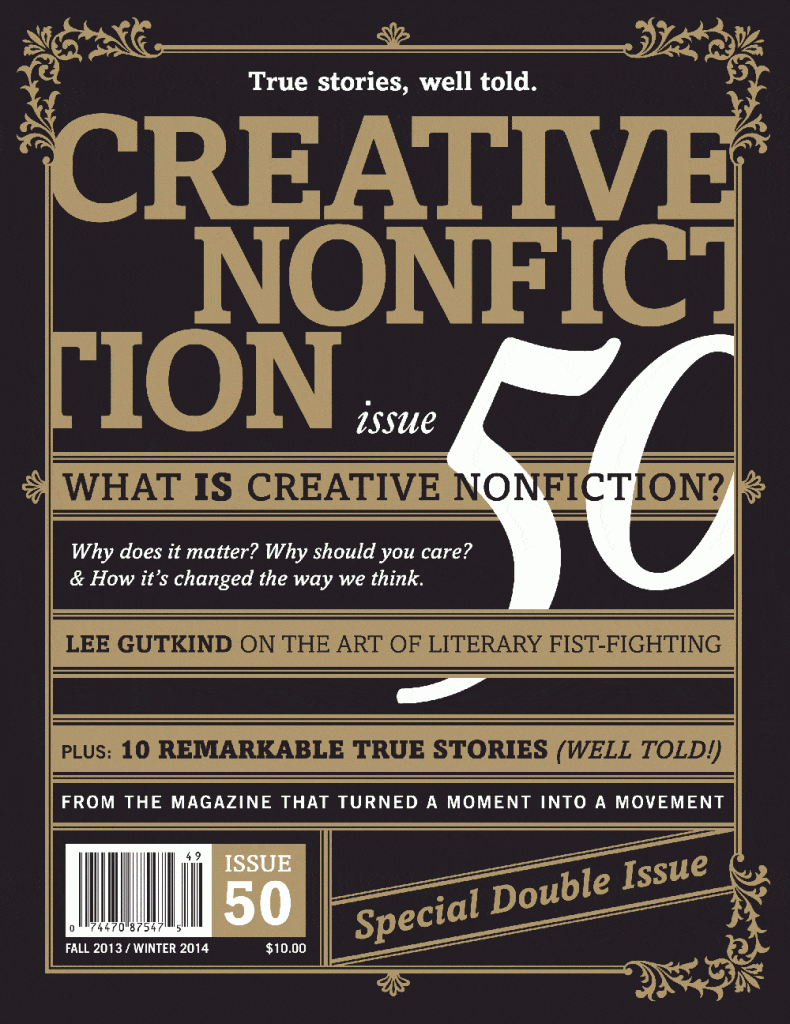Issue 50 / Fall 13/Winter 14

50 / CNF Gold
Celebrating 50 issues (and nearly 20 years) of true stories, well told
Our 50th issue is a big deal–and that’s not just hype. CNF #50 is nearly double the length of a normal issue of Creative Nonfiction.
To celebrate almost 20 years of literary publishing, we’ve created the ultimate reading experience. This issue serves as an in-depth primer and a kickass introduction for anyone new to the magazine (or the genre), while providing longtime readers with new insight and never-before-told stories about the origins of Creative Nonfiction–and a peek into the future–from founding editor Lee Gutkind.
PLUS: We’re bringing out some of our greatest hits. The issue features ten remarkable true stories from our first 50 issues, with new introductions from CNF editors past and present.
It’s Creative Nonfiction gold!
Already a subscriber?
Read this issue nowTable of Contents
What’s the Story #50
"This issue offers insight into the work, heartache, and challenges of publishing a literary magazine—and perhaps that's the most fitting way to make this milestone."“How Many Times Did You Almost Go out of Business with This Thing?”
Michael Rosenwald discovers what keeps CNF’s founding editor goingIntro to “Meander”
I have vivid memories of working on the first issue of Creative Nonfiction with my wife (now my ex-wife), Patricia Park. We spread the manuscripts out on our dining room table, selected what we were going to publish, and edited and copyedited and proofread them carefully.Meander
A Nova show about the forms of nature prompts me to look up meander. Having always used the word to refer to walking, I am surprised to learn that it comes from water.Intro to “The Necessity of Poetry”
In the early days of the journal, all of the submissions arrived in hard copy, and it was easy to recognize patterns having to do with the writer or the subject.The Necessity of Poetry
Wartime childhood, a father’s generosity, and the passing of time: memory fragmentsIntro to “Three Spheres”
Issue 3 holds a special place of importance to me: It not only marked the first Creative Nonfiction that I worked on from start to finish, but it also marked my return to the workforce after several years at home, raising three children.Three Spheres
A therapist is forced to revisit her past when assigned to treat a woman in an institution where she herself was once a patient.Intro to “Love Letters”
The “universal chord” theme of Issue 9 referred to the process of turning the private into the public, the personal and mundane into something universal and meaningful. In keeping with our goal of publishing new, untried authors, this issue included pieces by Megan Foss and Priscilla Hodgkins, both being published for the first time.Love Letters
"The first time my old man went to prison I wrote him letters. I wrote Darryl long rambling letters that went on for 10 or 11 pages."Intro to “Ramalamadingdong”
My first reaction to Creative Nonfiction’s issue 17 was to wince. The journal had the same front cover design for each issue back then, with only a color change and new number, and I suppose it was inevitable that canary yellow would come along eventually.Ramalamadingdong
Why rock 'n' roll songs have such silly lyrics.Intro to “Notes from a Difficult Case”
“Rage and Reconciliation” was my second issue as managing editor, and I have to admit my heart sank when Lee told me we were going to do an entire issue devoted to healthcare.Notes from a Difficult Case
Almost everyone I know advised me to sue. Their advice was not casual, because almost everyone I know is an attorney. As am I. At 42, I’d been an attorney almost half my life.Intro to “Hector and the Beauty Queens”
A few years ago, I went through a phase where I watched episode after episode of the reality show America’s Next Top Model. It was a guilty pleasure; I loved seeing the contestants pose for photo shoots in telephone booths or freshly dug graves.Hector and the Beauty Queens
We’re sorry; we’re currently unable to make this work available online.Intro to “Then You’ll Be Straight”
I began copy editing for Creative Nonfiction in 2005, with issue 26. At that time, the journal followed the AP Stylebook, which kicked my heiney at first, especially with its twisted rules regarding italics, which drove me to the edge of insanity.Then You’ll Be Straight
A gay, white professor takes a job at a historically all-black women’s universityIntro to “Eight Questions You Would Ask Me If I Told You My Name”
In February 2010, we re-branded and re-launched Creative Nonfiction, transforming it from a traditional literary journal to a quarterly magazine. The redesign was quite possibly one of the most challenging—and rewarding—projects we’d tackled up to then.Eight Questions You Would Ask If I Told You My Name
An imaginary—but also all-too-real—conversationIntro to “The Intimacy of Forks”
When we decided to dedicate an issue to food, we hoped (as we do with every theme issue) that we would get a wide range of stories, and we did—more than two hundred in all.The Intimacy of Forks
Your waitress knows you better than you know yourselfThe Square Root of True
A brief history of the #cnftweet.On the Fine Art of Literary Fist-Fighting
Lee Gutkind remembers the contentious years leading up to Creative Nonfiction’s debut.
